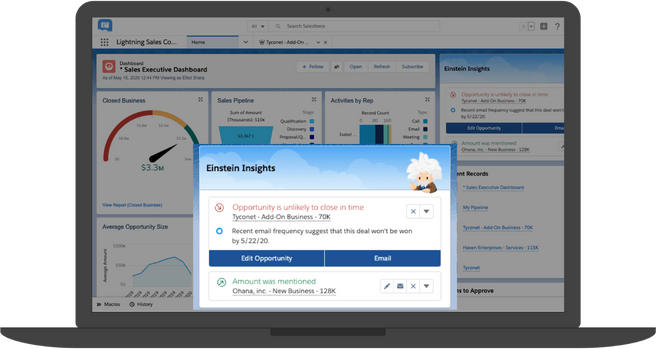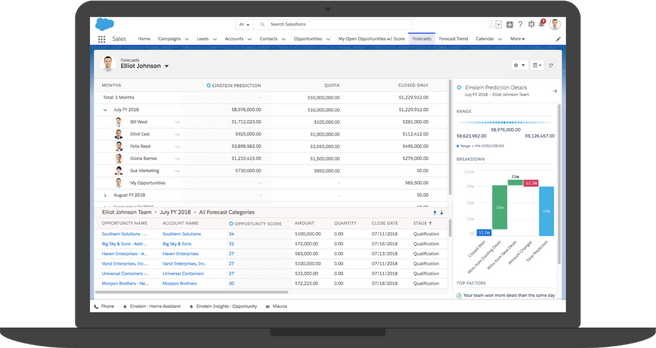
Sales Forecasting Techniques That Are Incredibly Helpful | Salesforce Sales Cloud
Contrary to popular belief, there's more than just maths, logic, and/or science to sales forecasting. There's also a considerable amount of art involved in these techniques. The whole point of a forecast can be distilled into two key points: how much the intended sales are, and by when that figure will be attained.
Read on for sales forecasting techniques that are incredibly helpful, whether you're a Salesforce admin or someone quite new to it:
Ask the Right Questions
While variables are a given when it comes to forecasts, there should also be consistent parameters throughout. We practice a good rule of thumb with our Salesforce managed services to consider what, where, who, why, and how. Build forecasts using the following framework:
What: The very foundation of forecasts must be the solutions intended for selling.
Where: Location, location, location! It's key to take note of where buying decisions are made by prospects, as well as where they will actually use the products at hand. If able, visit the locations for a more accurate gathering of data.
Who: The basis for forecasts by sales teams should always be the prospects.
Why: The forecast should be able to determine why existing customers and prospects alike are even looking into new services at all. A deal can stall if there's no forcing function involved.
![]() Don't forget to check out: 8 Salesforce Sales Cloud Tips To Boost Your Productivity and Drive Revenue
Don't forget to check out: 8 Salesforce Sales Cloud Tips To Boost Your Productivity and Drive Revenue
One of the most important pieces of data is how purchasing decisions are made by the prospect. Not accounting for previous patterns can make things rather tricky.

Sales Cloud Einstein Conversation Insights helps analyze specific phrases and map out trends. This enables managers to rethink sales methods to provide the right products to the right prospects and consumers at the right time. As new developments emerge, companies are convinced that AI will begin to assist sales teams in novel ways.
Involve Everyone Because It's Not Just the Sales Team Who Needs Forecasts
It can be easy to assume that forecasts are solely meant for sales leaders. In truth, the sales forecasts matter to each concerned department. If forecasts are off, even the likes of product delivery and customer service can be affected. Don't make the mistake of undermining just how important a forecast is for the entire company or organization.
A 360 dashboard provides sales managers and executives with a comprehensive view of all deals, allowing them to make accurate projections and identify which agreements are likely to fall through. For instance, if a sales representative leaves the company, the information on their account is preserved for other sales reps in the company to refer to. This will keep the connection going smoothly, minimizing the risk of customer churn.
Data is used to inform business decisions ranging from staffing to regions. Good decisions are based on good, clear data.
Keep in Mind That Forecasts Can Change at Any Second
As solid as the forecast can seem when it's finalized, many things can suddenly force a shift. Economic crises, global pandemics, and extreme weather can all contribute to a need for your forecast to change, sometimes entirely.
In those cases, a key reminder is to take the time to process the goings-on and breathe. Yes, the work is important; in many ways, this is part of the work! It also helps to nurture relationships with clients amidst the goings-on.

-
How does the pipeline look at present?
-
What are the best-case scenarios? The worst-case?
-
What changes have happened to the forecast compared to last week? Last month?
Data has to be as updated as possible given the circumstances. This is to ensure that the responses to these questions are dissected and disseminated properly.
With tools like Sales Cloud's built-in Pipeline Inspection, this is a simple operation. You may quickly filter chances by team or time period and see the most recent activity all on one screen. This allows your team to understand what's going on right now, what's likely to happen next, and what information is missing.
![]() Check out another amazing blog by Apphienz here: Salesforce - The Best CRM For Startups
Check out another amazing blog by Apphienz here: Salesforce - The Best CRM For Startups
Conclusion
Sales forecasting sounds easy, but it's actually a delicate balance of science and art. It's guesswork but amplified and supported by facts and data. Key techniques include asking the right questions, remembering to involve everyone, and keeping in mind that forecasts can change at any second.
Looking to transform your business? Reach out to Apphienz or write to us at [email protected]. We believe in customizing and personalizing your business strategies to the best of our abilities so we can help you reach your goals.




Responses